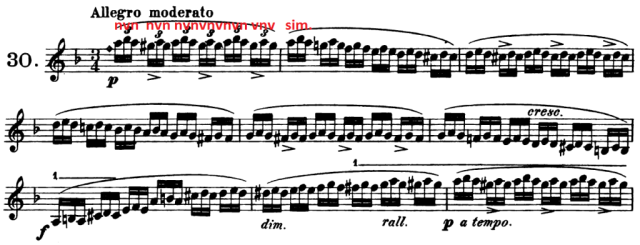“What is your etude for your exam …?”
“It’s Kaiser No. 30. There are so many notes and it’s fun!”
“Oh, really ?! I’m glad you like it, but doesn’t your hand get tired?”
“Um … No, it’s all right!”
“Can you play a bit?”
♪ ♪ ♪ ♪
“Thank you. I’m sorry to stop you, but there are a couple of problems.
Do you know what’s wrong?”
“???”
Problem 1: Intonation
“First, the intonation. Western music is basically composed with whole steps and half steps, so you have to play them clearly so that the listeners can hear the clear difference. You play some half steps too wide, so some of the pitches (of the relationship) are not clear enough. On the violin, your fingers are placed right next to each other for the half step relationship. For the whole step, fingers have some distance.
From the bar 39 to bar 43, there are problems with both string crossings and the pitch. I recommend to start practicing this section today. You know what I’m talking about? Because we went over it at the last lesson, right?
You can work slowly for the section.

Problem 2: Unevenness
Another problem is the notes sound uneven, even though your fingers are moving OK. Can you hear the unevenness yourself? Sometimes, the third note of the group is longer than necessary and creates a strange rhythm.
I think it is happening because you are not thinking about each note.
This etude, Kayser no.30, has a lot of notes, but you have to be aware of each of them and play them while listening carefully. You cannot just move your fingers without thinking, or without controlling them.
How to practice
The first step I can suggest for you is to take the slurs out and play each note with separate bows.

You do not have to use this tempo, but you get the idea, right?
You have a slight problem of maintaining your concentration 🙂 also I can see you have some tension while you are playing, so if you get tired with both or one of your hands or arms, you can focus on the first page only at the beginning. Or it may be even better to divide a page in half, or one-third, or even one-quarter of short sections, and improve section by section.
By practicing this way, you may encounter another problem of coordinating the left fingers and bow control, so try to pick the tempo that you think you can play correctly. You don’t have to play fast. Again, the purpose of this practice is to be aware of each note.
This is just a reminder, but don’t forget to pay attention to your intonation as well.
I’m looking forward to hearing the result of your practice.”
** This article may be updated according to my students’ progress. (^^)
Another article: Kayser 36 Studies for violin no.22
This blog is listed in Feedspot